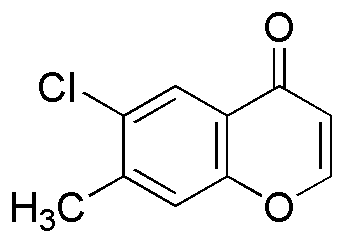6-Chloro-7-methylchromone is widely utilized in research focused on:
- Pharmaceutical Development: This compound serves as a key intermediate in the synthesis of various pharmaceuticals, particularly those targeting inflammatory diseases and cancer. Its unique structure allows for modifications that enhance therapeutic efficacy.
- Fluorescent Probes: It is employed in the creation of fluorescent probes for biological imaging. These probes help researchers visualize cellular processes in real-time, making it easier to study disease mechanisms.
- Natural Product Synthesis: The compound is used in the synthesis of natural products, particularly flavonoids, which are known for their antioxidant properties. This application is vital in the food and cosmetic industries where natural antioxidants are in high demand.
- Agricultural Chemicals: It finds application in developing agrochemicals, particularly as a plant growth regulator. This helps improve crop yields and resistance to pests, benefiting the agricultural sector.
- Material Science: The compound is explored in material science for creating novel polymers and coatings. Its chemical properties allow for enhanced durability and performance in various applications, including electronics and packaging.
General Information
Properties
Safety and Regulations
Applications
6-Chloro-7-methylchromone is widely utilized in research focused on:
- Pharmaceutical Development: This compound serves as a key intermediate in the synthesis of various pharmaceuticals, particularly those targeting inflammatory diseases and cancer. Its unique structure allows for modifications that enhance therapeutic efficacy.
- Fluorescent Probes: It is employed in the creation of fluorescent probes for biological imaging. These probes help researchers visualize cellular processes in real-time, making it easier to study disease mechanisms.
- Natural Product Synthesis: The compound is used in the synthesis of natural products, particularly flavonoids, which are known for their antioxidant properties. This application is vital in the food and cosmetic industries where natural antioxidants are in high demand.
- Agricultural Chemicals: It finds application in developing agrochemicals, particularly as a plant growth regulator. This helps improve crop yields and resistance to pests, benefiting the agricultural sector.
- Material Science: The compound is explored in material science for creating novel polymers and coatings. Its chemical properties allow for enhanced durability and performance in various applications, including electronics and packaging.
Documents
Safety Data Sheets (SDS)
The SDS provides comprehensive safety information on handling, storage, and disposal of the product.
Product Specification (PS)
The PS provides a comprehensive breakdown of the product’s properties, including chemical composition, physical state, purity, and storage requirements. It also details acceptable quality ranges and the product's intended applications.
Certificates of Analysis (COA)
Search for Certificates of Analysis (COA) by entering the products Lot Number. Lot and Batch Numbers can be found on a product’s label following the words ‘Lot’ or ‘Batch’.
Numéro de catalogue
Numéro de lot/série
Certificates Of Origin (COO)
This COO confirms the country where the product was manufactured, and also details the materials and components used in it and whether it is derived from natural, synthetic, or other specific sources. This certificate may be required for customs, trade, and regulatory compliance.
Numéro de catalogue
Numéro de lot/série
Safety Data Sheets (SDS)
The SDS provides comprehensive safety information on handling, storage, and disposal of the product.
DownloadProduct Specification (PS)
The PS provides a comprehensive breakdown of the product’s properties, including chemical composition, physical state, purity, and storage requirements. It also details acceptable quality ranges and the product's intended applications.
DownloadCertificates of Analysis (COA)
Search for Certificates of Analysis (COA) by entering the products Lot Number. Lot and Batch Numbers can be found on a product’s label following the words ‘Lot’ or ‘Batch’.
Numéro de catalogue
Numéro de lot/série
Certificates Of Origin (COO)
This COO confirms the country where the product was manufactured, and also details the materials and components used in it and whether it is derived from natural, synthetic, or other specific sources. This certificate may be required for customs, trade, and regulatory compliance.


